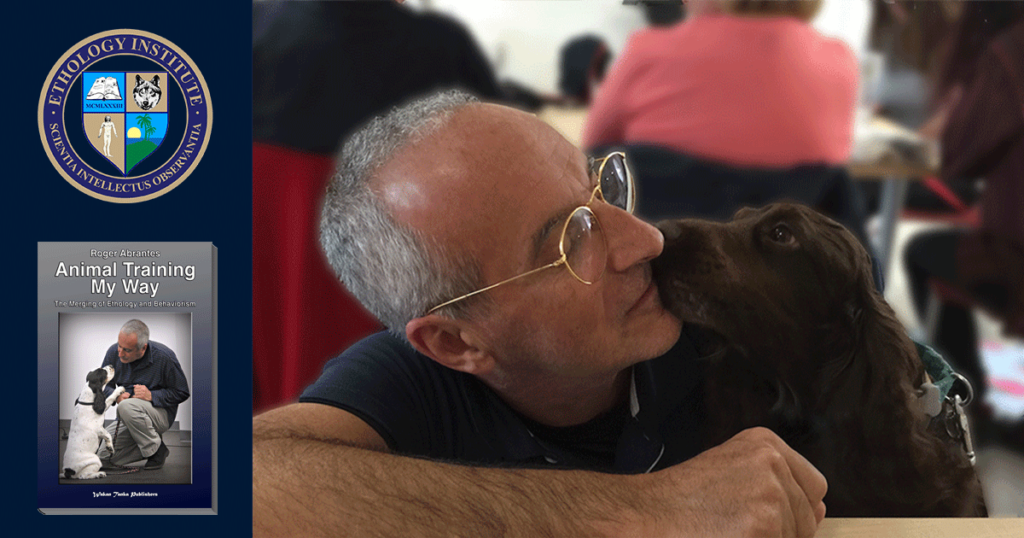Yes and no are two short words and, yet, they convey the most important information many living beings receive. On one level, this information regulates their organic and cellular functions; on another, their behavior, and ultimately, their survival. If I say these words don’t require any explanation, everyone would probably agree—and yet we’d be wrong. Did you know that in some languages, yes and no, don’t exist?
In my book “Psychology Rather Than Power,” written in 1984, I define ‘yes’ and ‘no’ in dog training for the first time. ‘Yes’ means “continue what you’re doing now,” and ‘no’ means “stop what you’re doing now.” I explain how to teach our dogs these signals, and I emphasize that ‘no’ is not an inhibitor (earlier called a punisher) and that it should always be followed by a reinforcer as soon as the dog changes its behavior.
As the years passed, I reviewed, improved, and refined all definitions, especially how to teach dogs these signals. In 1994, I wrote the first draft of SMAF, which provided the opportunity to analyze signals and teaching methods (POA=plans of action) with increased precision. The definitions of ‘yes’ and ‘no’ remained the same. However, SMAF enabled us to distinguish clearly between the two entirely different ways dog owners and trainers used the sound ‘no.’ One was a signal, as I describe; the other was an inhibitor. The inhibitor ‘no’ was pronounced more harshly than the signal ‘no’ but was fundamentally the same sound. Transcribing it into SMAF, we did not doubt that they were two different stimuli. The signal is No(stop what you are doing right now),sound(no), and the inhibitor is [!+sound](no).
Using an inhibitor as a signal to encourage the dog to do something is never a good idea as an inhibitor’s function is to decrease the frequency, intensity, duration, or topography of a particular behavior. Conversely, a signal’s function is to produce a behavior that we increase in frequency, intensity, or duration by reinforcing. Therefore, to strengthen the effectiveness of No,sound (the signal), we had to explain to owners and trainers very carefully that they should never use ‘no’ as an inhibitor. Amazingly (or perhaps not), many dogs could distinguish between the two ‘no’s,’ but we didn’t want to risk them forming a respondent association between the sound ‘no’ and an aversive. We would use any other sound (word), e.g., ‘phooey’ (‘fy’ or ‘føj’ in the Scandinavian languages), as an inhibitor.
Why the word ‘no’?
The word ‘no’ seemed to me at the time the best option to convey, “stop what you are doing right now.” After all, implicitly or explicitly, this is the way most of us use the word (when we have it in our language, that is). Of course, some people cannot say ‘no’ tactfully, but some people having bad manners shouldn’t detract from the meaning or value of the word, per se.

All infants have an innate understanding of ‘yes’ and ‘no’. Their bodies function on ‘yes’ and ‘no’. Their survival depends on it (Photo by Mike Robinson).
The magic words ‘yes’ and ‘no‘
‘Yes’ and ‘no’ are two words used for expressing affirmatives and negatives. The words ‘yes’ and ‘no’ are difficult to classify under one of the eight conventional parts of speech. They are not interjections (they do not express emotion or calls for attention). Linguists, sometimes, classify them as sentence words or grammatical particles.
Modern English has two words for affirmatives and negatives, but early-English had four words: yes, yea, no, and nay.
If you’re a native English speaker, you know what yes and no mean, and you have no problem using these words, from a linguistic point of view. You might have a problem using the word no from a psychological point of view, but that’s an entirely different story.
If you are a native English speaker and have never ventured into learning other languages, you probably believe there is no problem in answering any question with yes or no. After all, most things either are or are not, are either true or false, right? I’m afraid I’m going to disappoint you by demonstrating that you are wrong.
Even though some languages have similar words for yes and no, we do not use them to answer questions. For example, in Portuguese, Finnish and Welsh, you rarely reply to a question with yes and no. Portuguese: “Estás bem?” (Are you OK?) “Estou” (I am). Finnish: “Onko sinulla nälkä?” (Are you hungry?) “On” (I am). Welsh: “Ydy Ffred yn dod?” (Is Ffred coming?) “Ydy” (He is coming).
In Scandinavian languages, French and German (amongst others), you answer questions with yes and no. However, you have two different ways of saying yes depending on whether the question is an affirmative response to a positively-phrased question or an affirmative response to a negatively-phrased question. In Danish and Swedish, you say (ja, jo, nej), in Norwegian (ja, jo, nei), in French (oui, si, non), and in German (ja, doch, nein).
So far so good, but if you venture into the Asian languages, it gets far more complicated. Some Asian languages don’t have words for yes and no. In Japanese, the words はい (hai) and いいえ (iie) do not imply yes and no, but agreement or disagreement with the statement of the question, i.e. “agree.” or “disagree.” はい can also mean “I understand what you’re saying.” The same in Thai: ใช่ (chai) and ไม่ใช่ (maichai) indicate “correct,” “not-correct.” In Thai, you can’t answer the question “คุณหิวข้าวไหม” (Are you hungry?) with “ใช่” (correct). It doesn’t make sense, for what is it that you are confirming to be correct? The right answers are “หิว” (hungry) or “ไม่หิว” (not hungry). In all Chinese dialects, yes-no questions assume the form “A or not-A” and you answer echoing one of the statements (A or not-A). In Mandarin, the closest equivalents to yes and no are 是 (shì) “be” and 不是 (búshì) “to not be.”
Latin has no single words for yes and no. The vocative case and adverbs do it, instead. The Romans used ita or ita vero (thus, indeed) for the affirmative, and for the negative, they used adverbs such as minime, (in the least degree). Another common way to answer questions in Latin was to repeat the verb like in Portuguese, Castellano and Catalan (e.g. est or non est). We can also use adverbs: ita (so), etiam (even so), sane quidem (indeed, indeed), certe (certainly), recte dicis (you say rightly) or nullo modo (by no means), minime (in the least degree), haud (not at all!), non quidem (indeed not).
In computer language, yes and no appear as a succession of “A or B” conditions. If condition A is true, then action X. A computer’s CPU only needs to recognize two states for us to instruct it to perform complicated operations: on or off, yes or no, one or zero.
The theories of quantum computation suggest that every physical object, even the universe, is, in some sense, a quantum computer. The cosmos itself appears to be composed of yes and no. Professor Seth Lloyd writes: “[…] everything in the universe is made of bits. Not chunks of stuff, but chunks of information—ones and zeros. […] Atoms and electrons are bits. Machine language is the laws of physics. The universe is a quantum computer.”
The way computers use yes and no is the closest to our customary use of these terms. ‘Yes’ means “continue what you are doing right now.” ‘No’ means “stop what you are doing right now.” That is the implied meaning of yes and no in the majority of the sentences. “Are you hungry?” The answer “yes” would result in you getting food and “no” in the opposite. “Shall I turn right? ” followed by a ‘yes’ would make me continue with what I intended to do and if followed by a ‘no,’ would make me stop doing it. A ‘yes’ in response to “Did you buy rice, today?” would prompt me to continue doing whatever I might be doing and a ‘no’ would lead me to interrupt my errand to go and buy some rice. There are many other examples, but in general yes prompts or encourages a continuation, and no does the opposite. There is nothing particularly positive or negative in either. Both are valuable bits of information that we can transform into behavior to our benefit. Both save energy, the most precious resource for all living organisms.
Two peculiar aspects of ‘yes’ and ‘no’
As we have seen, some languages don’t have words for ‘yes’ and ‘no.’ That is a cultural phenomenon. For example, in Japan and Thailand, it is bad manners to be direct. Japanese and Thai people consider ambiguity to be a beautiful aspect of their language. The objective in courtesy is to convey the true meaning between the lines. The way one delivers a message should be as unclear as possible, especially when criticizing someone or rejecting an invitation. This linguistic feature is probably related to the sense of self-respect and honor so pronounced in both cultures, i.e. one doesn’t want to hurt other people’s feelings or lose face.
For example, I can’t say to a Thai employee that arrives late to work, “Arriving late is not acceptable. Please, rectify this in the future.” If I do, I won’t have an employee coming to work at all the next day or maybe ever again. I’d have to say, “If we had employees that arrived late, we would have to ask them to come at the right time, don’t you think?” That would have the desired effect. If you invite a Japanese to an event that he or she is not the least interested in, they will answer “I want to come, but unfortunately, it is impossible on that day.” That would suffice for me to understand that they are not interested without making me lose face. Suggesting another day (and missing the point) is considered impolite.
Thais use ครับ (khrap, by men), ค่ะ (kha, by women) and the Japanese use はい (hai) to show that they are listening to you because it is impolite for them to let you talk for any length of time without their acknowledgment. However, it does not mean they agree with what you are saying, they will comply, or that they even understand you.
Regarding animal training, a signal is “everything that intentionally changes the behavior of the receiver.” A command is “a signal that intentionally changes the behavior of the receiver in a specific way with no variations or only minor variations.” The words ‘yes’ and ‘no’ are probably the closest we come to commands. ‘Yes’ means continue and ‘no’ means stop and, as to most behaviors, there are few possible variations in continuing or stopping, if any).
Is ‘no’ a bad word?
‘No’ is not a bad word. On the contrary, it is a very useful word. It conveys information in a precise and efficient way. To get ‘no’ as an answer is as important as getting a ‘yes.’ Both save us energy and lead us to our goal. Personally, I like the words yes and no equally, and I wished people would learn to use them properly and more often.
The other day, I went into a store at a busy hour, and I didn’t have the time or the patience to wait. I said to one employee: “Excuse me, I have a question that you can answer quickly with a yes or no. Do you have a Time Capsule 2TB?”
“I have one, but it’s reserved for a customer,” he answered.
“What does that mean? Is he coming to pick it up or not?” I asked again.
“Yes, he is.” He answered.
“Well, then that’s a no, right?” I asked.
“Yes,” he said.
Why couldn’t he just have said no the first time? It would have saved us all time: me, the other customers in the line, and not least himself.
Another example:
United Airlines desk at the gate boarding to ORD: I approach and ask: “Do you have an empty seat on this flight?”
The United operator answers me: “That depends on your ticket, sir.”
“No, it doesn’t,” I reply, “whether or not you have empty seats does not depend on my ticket, It depends on whether all the seats will have butts on or not.”
A colleague of hers smiles and checks it. “Sorry, sir, this flight is fully booked. I have one seat on the next flight, but… it’s business class.”
“No ‘but.’ You can put a comma or an ‘and’ in there,” I say. It blows my mind. A seat is a seat, and that’s what I requested. A seat is not less of a seat because it is a business class seat.
“Excuse me, sir?” she replies with a smile, plainly not understanding my comment based on linguistics/logic.
“Never mind. Here’s my frequent flyer card. I have an e-ticket for the 7.13 pm flight. Please, upgrade it with my miles. Thank you.” I say smilingly, in an attempt to reinforce her behavior for having been able to think clearly (yes/no) for two seconds and for checking the availability on the next flight.
“Yes, sir.” Finally a short and precise answer!
Why couldn’t they have answered first ‘no’ and then ‘yes’ until they got the next bit of information if I had any to give them? It would have saved me (and them) time and energy. If the lack of words for ‘yes’ and ‘no’ in Asian languages is frustrating for the Western communicator, the refusal to use them, or their incorrect usage in languages where they exist and are well defined, is exasperating.
Why don’t some people like the word ‘no’?
Cultural differences apart, some people don’t like the word ‘no’ for the same reason that some dogs don’t like it: they associate ‘no’ with aversives. Parents are just as bad as dog owners in distinguishing between signals and inhibitors, and they make identical mistakes, which will later create problems to their children.
Of course, parents have to yell ‘no’ if the toddler is about to stick his fingers in the wall outlet (plug socket). There’s nothing wrong with that. What is incorrect, and creates the aversive respondent association with ‘no’, is the constant repetition without a reinforcer when the behavior stops. The toddler only learns that, sometimes, parents go berserk, and she has no idea why or how to avoid it. The toddler becomes so sensitive to the word ‘no’ that later, like many others, he or she would rather live with regret than to risk hearing a ‘no.’ This conditioning can also happen subsequently, in adult life, to which abusive parents, enraged spouses, and tyrannical bosses all contribute.
An elementary mistake, committed by both parents and dog owners, adds to the aversive connotation of ‘no.’ If we have to use inhibitors, we should never (ever) inhibit the individual, only the behavior. Inhibiting the individual may create traumas, a lack of self-confidence, the feeling of rejection, etc. Inhibiting the individual rather than the behavior can even produce aggressive behavior instead of decreasing the expected behavior.
The reason some people don’t like ‘no’ has nothing to do with the word or the message conveyed, but with the aversives to which it was (respondently) conditioned. Changing that goes beyond the scope of biology, animal behavior, and linguistics, and pertains to the realm of psychology.
Still, there’s nothing wrong with the word ‘no’ and particularly not with the message it conveys. There is something wrong with abusive parents, enraged spouses, tyrannical bosses and ignorant people (all potentially abusive animal owners). To forbid the word ‘no’ or to replace it with another, e.g. ‘stop,’ does not resolve the problem. The only thing that does solve the problem is to educate people, to teach them to respect others independently of species, race, and sex.

English Springer Spaniel on the trail: ‘yes’ and ‘no’ are indispensable tools to direct the dog.
‘No’ in dog training
The signal ‘no’ is indispensable in dog training. I use it constantly when training detection dogs, rats, and Guinea pigs and the animals respond correctly with no emotional response at all. I give the signal ‘search’ using sound, the dog searches, I reinforce it. I give the dog the signal ‘no,’ the dog changes direction, I reinforce it. If the dog stops and looks at me, I give the signal ‘direction’ with a stretched arm toward the desired target, I give the signal ‘search’ employing sound, the dog searches and I reinforce it. If necessary, while the dog searches, I can signal ‘yes’ to encourage the dog to continue searching (‘yes’ functions here as a signal and a reinforcer, not an exception at all).
For those of you proficient in SMAF:
PRS1. {Search,sound => Dog searches => “!±sound”};
PRS2. {No,sound => Dog changes direction => “!±sound”};
ALT2. {No,sound => Dog stops and looks at me => Direction,arm + Search,sound => Dog searches => “!±sound”};
If necessary:
PRS1. {Search,sound => Dog searches => “!±sound” => Dog searches => Yes,sound}; /* Yes,sound also functioning as “!±sound */
In languages where there are no words for ‘yes’ and ‘no,’ such as Thai, I use ใช่ (chai=correct) and หยุด (yut=stop) respectively for “continue what you are doing right now” and “stop what you are doing right now.” I don’t use ไม่ใช่ (maichai=not correct) because the sound is too close to ใช่ (chai=correct).
Some trainers don’t allow their dog owners to say ‘no’ at all in their classes. That is an option, particularly if we have a class full of badly-mannered dog owners, but if our class consists of average, well-mannered owners, I cannot see any reason to do so. If they are not well-mannered, maybe they should learn to be so before beginning training their dogs; and perhaps, by training them to be polite to their dogs, we could even make a change for the better in their lives in general by teaching them good manners toward their fellow humans as well.
Forbidding the signal ‘no’ in dog training is a grave mistake (and misunderstanding) in my opinion. Firstly, it is one of the two most critical signals in life. Secondly, we all need a quick, efficient signal to stop a behavior which might be fatal for someone we care about (human or animal). Thirdly, it would be an untenable waste of time and energy if we had to resort to diverting maneuvers every time someone (our dogs included) did something undesirable.
Substituting the signal ‘no’ with other sounds (words) such as ‘stop,’ or ‘off’ doesn’t solve the problem. It only transfers the conditioning to those new words. The problem is that some people just can’t speak nicely to anyone. Most dog owners yell their dog’s name, and they yell ‘come.’ What are we going to do about that? Forbid them to use their dog’s name and the word ‘come’? What’s the next thing we are going to forbid them? Rather than banning words, it seems to me a much better option to teach them to communicate properly. We need to explain to them that the words they use, the way they use them, are not signals but inhibitors and, by definition, they will not achieve the desired result. Quite the contrary, they will get an undesired outcome. We need to show them how appropriate signals produce appropriate behaviors.
Bottom-line: The fact that some languages don’t have words for ‘yes’ and ‘no’ and that Latin uses quantifiers instead, suggests there are cognitive as well as emotional elements connected to the meaning of both words. Maybe the logical human brain likes the precision and simplicity implied in ‘yes’ and ‘no,’ but the emotional human brain doesn’t. The universe and computers have no issues with ‘yes’ and ‘no’ perhaps because they are not emotional. Maybe ‘yes’ and ‘no’ appeared in some languages at a stage when action became more decisive than emotion. We don’t know. I haven’t been able to clarify any of these questions. Nevertheless, ‘yes’ and ‘no’ convey important bits of information in a succinct and precise way. In the languages, which contain them, we can use them correctly for our benefit.
Enjoy and don’t feel guilty because you are well-mannered and know how to say no.
References
- Abrantes, R. (2011). Mission SMAF—Bringing Scientific Precision into Animal Training.
- Abrantes, R. (2011). Signal and Cue—What is the Difference?
- Abrantes R. (2011). Commands or Signals, Corrections or Punishers, Praise or Reinforcers.
- Abrantes, R. (2011). Unveiling the Myth of Reinforcers and Punishers.
- Bloomfield, L. and Hockett, C. F. (1984). Language. University of Chicago Press.
- Boyd, K. M. and Osborn K. (1997). The Complete Idiot’s Guide to Parenting a Preschooler and Toddler, Too.
- Lloyd, S. (2006). Programming the Universe: A Quantum Computer Scientist Takes On the Cosmos. Alfred A. Knopf Publishers.
- Mueller, S. (2011) Learn to say “No.
- Powell, C. S. (2006). Welcome to the Machine. The New York Times. Retrieved 2009-06-08.
- Seife, C. (2006). Decoding the Universe. Viking Books.
- Sichel, M. and Cervini, A. L.A. Boundary is NOT a Rejection.
- Sonnenschein, E. A. (2008). Sentence words. A New English Grammar Based on the Recommendations of the Joint Committee on Grammatical Terminology. Read Books.
- Watts, R. J. (1986). Generated or degenerate? In Dieter Kastovsky, A. J. Szwedek, Barbara Płoczińska, and Jacek Fisiak.Linguistics Across Historical and Geographical Boundaries. Walter de Gruyter.
- Visual Thesaurus
- Wikipedia. Yes and No.
- Williams, C. P. and Clearwater, S. H. (1999). Ultimate Zero and One: Computing at the Quantum Frontier. Kindle eBook.
Featured image: ‘Yes” and ‘no’ are the two single most important signals in the universe. Photo: Atlantic puffins, Vesterålen, by Billy Idle.
Featured Course of the Week
Ethology Ethology studies animal behavior in its natural environment. It is one of the fundamental courses in your curriculum. A reliable knowledge of animal behavior is the basis to create a satisfying relationship with any animal we train.
Featured Price: € 168.00 € 98.00

Learn more in our course Ethology and Behaviorism. Based on Roger Abrantes’ book “Animal Training My Way—The Merging of Ethology and Behaviorism,” this online course explains and teaches you how to create a stable and balanced relationship with any animal. It analyses the way we interact with our animals, combines the best of ethology and behaviorism and comes up with an innovative, yet simple and efficient approach to animal training. A state-of-the-art online course in four lessons including videos, a beautiful flip-pages book, and quizzes.

